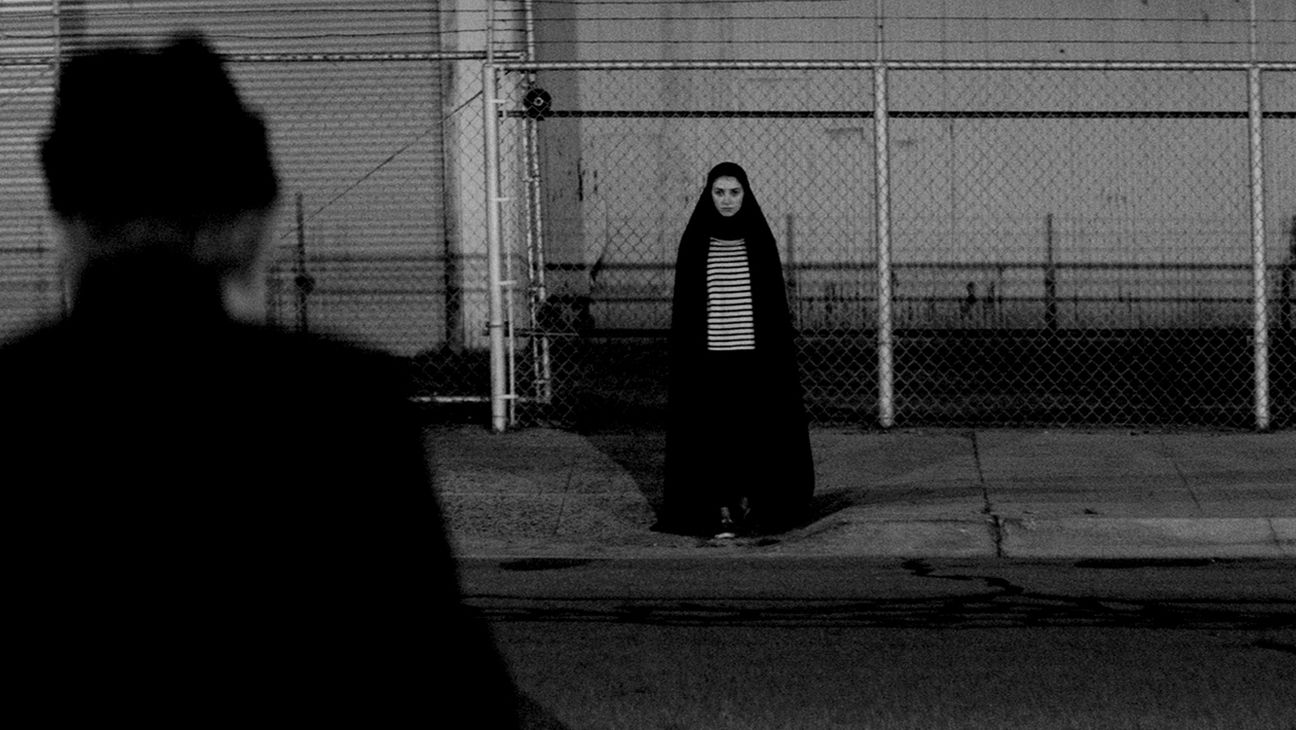A Girl Walks Home Alone at Night (2014, Dir. Ana Lily Amirpour):
Most vampire movies have become so pro forma in execution that one need only consult the synopsis to know where everything is heading. Interview with a Vampire-styled period finery and dissolution? Gotcha. Blade or Underworld, vampires as superheroes? Check. Twilight-like Gothic romance? Roger and out. But the genre is also flexible enough to accommodate offbeat gems like Let the Right One In and Thirst — a category to which Ana Lily Amirpour’s A Girl Walks Home Alone at Night proudly belongs.
A Girl is impossible to encapsulate in a tidy summary, which is only fitting given the myriad influences Amirpour sprays across the screen like shotgun fire: the expressionism of F.W. Murneau, the naturalism of New Wave Iranian cinema, the deadpan comedy of Jim Jarmusch, the occasional strut of a rockabilly musical, and the fatalistic sincerity of Nicholas Ray. It sounds like a recipe for cinematic overdose, but somehow in her first feature, Amirpour has fashioned a coherent world that’s distinctive and all its own.
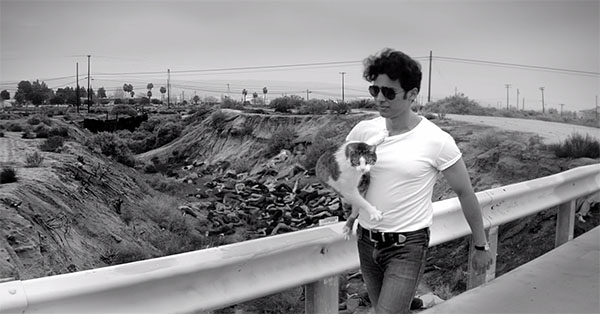
Speaking of Nicholas Ray, the film opens upon a rebel without a cause: Arash (Arash Marandi), an Iranian James Dean equipped with sunglasses, T-shirt, jeans and Thunderbird convertible. Almost immediately, Arash appropriates a cute stray cat, cementing the “misunderstood sensitive hero” look, yet in the next moment he strolls past a gully littered with corpses, the camera going slo-mo in unsettling fashion. Thus the vibe of A Girl Walks Home Alone at Night is set: expect to see a lot, but don’t expect to know what happens next.
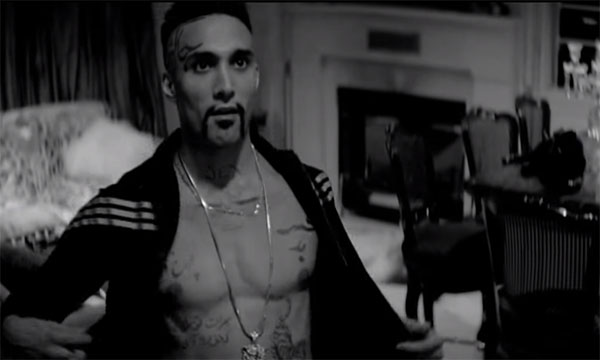
The story (written by Amirpour) unfurls with dream-like pacing, in a town known only as “Bad City” (actually Taft, southern California). Arash might act like a leading man in search of a grandiose narrative, but in this down-at-heel burg, he’s an ineffectual nobody, burdened by his drug-addict dad Hossein (Marshall Manesh) when he’s not being tormented by his dad’s dealer (Dominic Rains), a tatted-up pimp. Jacking Arash’s Thunderbird as collateral, snorting coke, pumping iron and abusing his prostitute Atti (Mozhan Marnò), Rains is a campy, creepy commentary on machismo run amuck. The situation calls for a hero, or at least an anti-hero, to set things straight — and that’s when our focus shifts to the titular girl (Sheila Vand), who appears on the scene like a specter, mute and feral. No pussyfooting here: she reveals herself almost immediately as a vampire, in an attack that is by turns hilarious, phallic, sensuous and genuinely shocking.
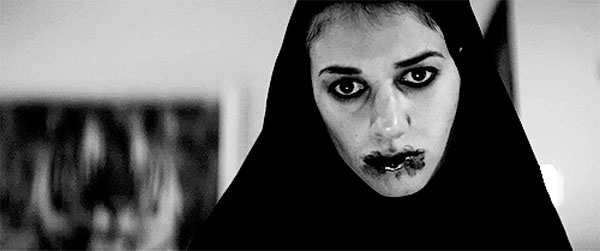
A girl without a past, a boy without a future — the stage is set for love, and while A Girl Walks Home gestures towards the ill-fated romance template, Amirpour is more interested in subtext and mood. It turns out that Vand’s vampire is something of an avenging feminist angel, outing her intentions in her first line of dialogue to an innocent lad (Milad Eghbali): “Are you a good boy?” Lucky for him, he is; all her other victims are very bad boys, indeed (whether one can chalk up her choice of prey to genetic necessity or moral imperative is left tantalizingly unanswered). At night, silent and draped in a traditional hajib and chador, her presence suggests the reach of an inescapable past, but hiding out at home in daylight, she could be any melancholic hipster with her bobbed hair and striped French New Wave blouse. Striking poses like Greta Garbo, this is one girl who wants to be alone with her electro-pop tunes, and Madonna, Bee Gees and Michael Jackson posters — but as is the curse of all vampires, human contact is a necessity.
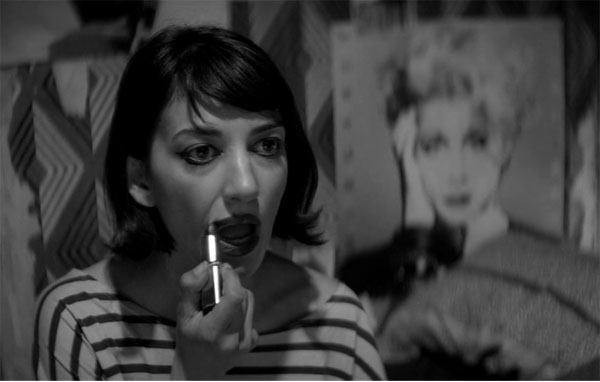
A Girl Walks Home Alone at Night settles into a series of vignettes, as the girl and Arash circle each other, the lines between prey and lover blurred up. In a wry twist on the usual mythos, the naive, clueless would-be victim is a hunky guy, and the likable Marandi is appropriately bewildered in the role. Alternating between stuttery frames and fluid tracking shots, or sidling up to characters’ faces, Lyle Vincent’s black-and-white cinematography is vibratingly alive, as if tuned in directly to the girl’s thirsty wavelength. Most vampire films go sullen and portentous, following the lead of their protagonists; Amirpour and Vand go riot grrrl instead, slipping in irreverent sight gags and punky interludes in night clubs. While not every visual non-sequitur hits — a bit with a drag queen frolicking with a black balloon smacks of art-house weirdness for weirdness’ sake — there’s plenty of indelible scenes, including the sight of Vand gliding down moonlit streets on skateboard, or Arash in a Halloween Dracula costume, high on E as he meets cute with Vand. As the Death song “White Lies” grooves away on her LP player, a mirrorball throwing shivers of light everywhere, Vand hovers mere centimeters from Arash’s neck, in as sweetly rapturous a moment as you’ll find in recent film.
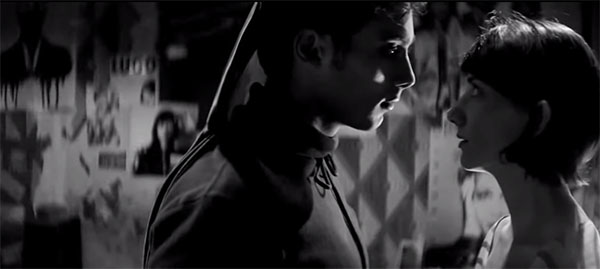
Arash Marandi and Sheila Vand in “A Girl Walks Home Alone at Night”
Pop-smackingly cool moments like these alternate with bleaker elements, including Marnò’s vampy performance as the aged, on-the-ropes prostitute, and Arash’s fraught relations with Hossein, who can’t escape memories of the homeland. The soundtrack is a disorienting swirl of amplified ambient noises. Declarations of love take place against the backdrop of oil derricks, pumping up and down in an ironic frenzy, while the sting of a spaghetti western guitar hints at a grandeur just out of reach. Romance is continually thwarted in A Girl Walks Home Alone at Night, the title of the movie itself suggesting a dead end, especially when Amirpour shepherds what there is of the plot towards a potentially tragic conclusion. But the movie ultimately takes its lead from a TV talking head that declares early on: “Don’t count the things you’ve lost. Count what’s still left.” Flirty and playful in its utilization of tropes, sneaky in its subversion, A Girl Who Walks Home Alone at Night opens itself up to myriad interpretations, even as it holds out hope for acceptance and escape. Like the pop songs that blare bright on Vand’s LP player, it’s a siren call amidst squalor.
